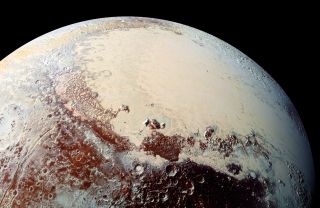What's That On Pluto? Official Names Near for Dwarf Planet Geography

Pluto's famous heart-shaped feature is on the road to getting an official name, nearly two years after its discovery. "Tombaugh Regio" — nicknamed after the discoverer of Pluto, Clyde Tombaugh — is among dozens of informal names that will likely be submitted to the International Astronomical Union (IAU) under new naming themes for the dwarf planet and its moons.
Pluto and its moons Charon, Nix, Styx, Kerberos and Hydra got a close-up from the New Horizons spacecraft flyby in 2015, revealing many surprises, such as mountain ranges on Pluto. It was the first time Pluto's system was viewed by a spacecraft from up close. As data flowed back to Earth, the New Horizons teams gave informal names to features on Pluto and its moons.
Simultaneously, the team worked with the IAU — the arbitrator of astronomy names — to figure out the naming process for all of the newly visible features. The IAU announced the revised guidelines Thursday (Feb. 23). The revised naming themes include underworld gods or explorers for Pluto, fictional space exploration vessels for Charon, river gods for Styx and dogs from literature for Kerberos, among others. ['Land; on Pluto in Amazing Color (Video)]
"I'm very happy with both the process and partnership that New Horizons and the IAU undertook that led to wonderful, inspiring and engaging naming themes for surface features on Pluto and its moons," Alan Stern, New Horizons' principal investigator and a researcher at the Southwest Research Institute, said in a statement. "We look forward to the next step — submitting actual feature names for approval."
Some of the new names will come from a database created by the public under the Our Pluto naming campaign, which ran in 2015. At the time, the IAU's working group for planetary system nomenclature offered naming themes for the six worlds in Pluto's system.
"The public responded with overwhelming enthusiasm, suggesting and voting on thousands of names within these categories, as well as proposing names not fitting the approved set of themes," IAU officials said in the same statement.
A timeline for naming the features officially was not released.
Get the Space.com Newsletter
Breaking space news, the latest updates on rocket launches, skywatching events and more!
Here is the full list of feature names, quoted from the IAU release:
Pluto:
- Gods, goddesses and other beings associated with the underworld from mythology, folklore and literature.
- Names for the underworld and for underworld locales from mythology, folklore and literature.
- Heroes and other explorers of the underworld.
- Scientists and engineers associated with Pluto and the Kuiper Belt.
- Pioneering space missions and spacecraft.
- Historic pioneers who crossed new horizons in the exploration of the Earth, sea and sky.
Charon:
- Destinations and milestones of fictional space and other exploration.
- Fictional and mythological vessels of space and other exploration.
- Fictional and mythological voyagers, travelers and explorers.
- Authors and artists associated with space exploration, especially Pluto and the Kuiper Belt.
Styx:
- River gods.
Nix:
- Deities of the night.
Kerberos:
- Dogs from literature, mythology and history.
Hydra:
- Legendary serpents and dragons.
Follow Elizabeth Howell @howellspace, or Space.com @Spacedotcom. We're also on Facebook and Google+. Original article on Space.com .
Join our Space Forums to keep talking space on the latest missions, night sky and more! And if you have a news tip, correction or comment, let us know at: community@space.com.

Elizabeth Howell (she/her), Ph.D., is a staff writer in the spaceflight channel since 2022 covering diversity, education and gaming as well. She was contributing writer for Space.com for 10 years before joining full-time. Elizabeth's reporting includes multiple exclusives with the White House and Office of the Vice-President of the United States, an exclusive conversation with aspiring space tourist (and NSYNC bassist) Lance Bass, speaking several times with the International Space Station, witnessing five human spaceflight launches on two continents, flying parabolic, working inside a spacesuit, and participating in a simulated Mars mission. Her latest book, "Why Am I Taller?", is co-written with astronaut Dave Williams. Elizabeth holds a Ph.D. and M.Sc. in Space Studies from the University of North Dakota, a Bachelor of Journalism from Canada's Carleton University and a Bachelor of History from Canada's Athabasca University. Elizabeth is also a post-secondary instructor in communications and science at several institutions since 2015; her experience includes developing and teaching an astronomy course at Canada's Algonquin College (with Indigenous content as well) to more than 1,000 students since 2020. Elizabeth first got interested in space after watching the movie Apollo 13 in 1996, and still wants to be an astronaut someday. Mastodon: https://qoto.org/@howellspace
